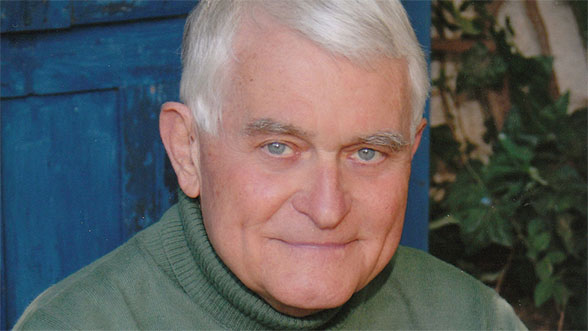Explore the Jack Eddy Fellowship
For postdoctoral students with strong interest in space weather, the connection between the Sun and climate, or other topics in heliophysics, the two-year NASA Jack Eddy Postdoctoral Fellowship is a career-defining opportunity.
Do you want to work on your own research project, not someone else’s? Do you want to approach this research from a broader perspective? Are you interested in doing your fellowship at a different institution, with a mentor with whom you are not currently working?
This is the spirit… that the Jack Eddy fellowship has, of exploring risky ideas that can change the way we understand the Sun-Earth system.
Andres Muñoz Jaramillo
Former Heliophysics Summer School student and Jack Eddy Fellow
Origin of the Jack Eddy Fellowship
The risk-taking spirit of the Jack Eddy Fellowship program is rooted in its namesake, John A. “Jack” Eddy (1931-2009). He was a pioneering solar researcher who proposed over thirty years ago that the Sun was a variable star, and that changes in long-term sunspot activity affect Earth’s climate.

John A. “Jack” Eddy. Credit: Barbara Eddy
Eddy’s idea of a Sun-climate connection was initially scorned. But eventually his findings convinced others, and he went on to make many other contributions to solar research, including his approachable primer on heliophysics, The Sun, the Earth, and Near-Earth Space: A Guide to the Sun-Earth System.
Lika Guhathakurta, lead program scientist for NASA’s Living With a Star Program (LWS) and the creator of the Heliophysics Summer School, had worked with and admired Eddy for years. He had been a consultant to LWS, and both he and Guhathakurta championed interdisciplinary study of the Sun’s relationship to Earth. After his death in 2009, Guhathakurta paid Eddy tribute by naming the new LWS postdoctoral fellowship after him.
How this fellowship is unique
The Jack Eddy Fellowship emphasizes interdisciplinary research. Because the goal of the program is to train the next generation of Sun-Earth system researchers, fellowships are awarded for projects that focus on aspects of interactions between the Sun, heliosphere, magnetosphere and ionosphere, as well as space weather and Sun-climate investigations.
Jack Eddy Fellows choose their own project to research. The fellowship is a guided opportunity for young scientists to explore the questions that interest them.
Jack Eddy Fellows work with a scientist and a host institution new to them. In the spirit of taking risks and making new connections, they cannot work with their PhD advisor.
For the Jack Eddy fellowship… you're expected to change institutions, that’s a mandatory requirement. People are encouraged to establish connections with scientists they are not working with, but that maybe they would like to.
Andres Muñoz Jaramillo
Former Heliophysics Summer School student and Jack Eddy Fellow
Jack Eddy Fellows also benefit from the partnership between NASA LWS and UCAR/CPAESS. They receive a fixed annual salary, UCAR’s extensive benefits package, and allowances for relocation, travel and publications.
Impact of the Jack Eddy Fellowship
Since its inception in 2009, this prestigious fellowship program has launched the careers of more than 30 potential stars in heliophysics. Alumni fellows work with NASA Jet Propulsion Laboratory, the Southwest Research Institute, and science departments of several leading universities worldwide.
If you lose this program, there is nothing like it… You will not be surprised to find some Jack Eddy Fellows now teaching at some universities… [They are] ready to be the future leaders and have real impact on the field.
Amitava Bhattacharjee
Astrophysicist and dean of the Heliophysics Summer School
Narayan Chapagain, a 2011 fellow who studied the effects of solar events on Earth’s ionosphere, returned to his native Nepal, where he spearheads related research efforts at Tribhuvan University.
Ryan McGranaghan, a data scientist with Atmospheric and Space Technology Research Associates, was a 2016 Jack Eddy fellow. He analyzed GNSS data to predict potential distortion of GNSS satellite signals by energy in space. Today he continues to use data science as a bridge between aerospace engineering and space physics.
Erika Palmerio, a 2019 fellow who studied in Finland and did her postdoc at the University of California, Berkeley studying space weather, anticipates her work having an influence on interplanetary travel.
During my PhD research I have worked on solar storms travelling from the Sun towards Earth, but as a Jack Eddy fellow I will also work on space weather events at Mars. This is very exciting for me, because the results of my research will make a valuable contribution to the current research that is into sending humans to the red planet.
Erika Palmerio
Former Heliophysics Summer School student and Jack Eddy Fellow
Jack Eddy Fellows even have an impact on heliophysics education. Several of these fellows had attended the Heliophysics Summer School before being awarded their fellowships, and a few of them have returned to give supplementary lectures and share their perspectives with the youngest members of the heliophysics community. This pleases Guhathakurta -- she describes the loop as a “heliophysics life cycle”.
If you, too, want to make an impact in the field of heliophysics, why not reach for the stars and be supported in your science? You might be the next Jack Eddy Fellow.



